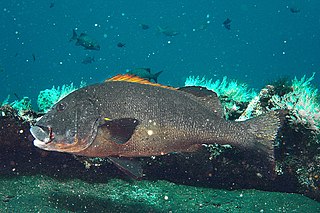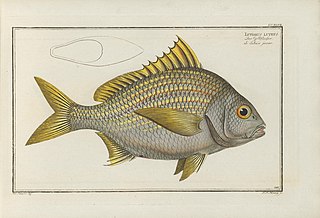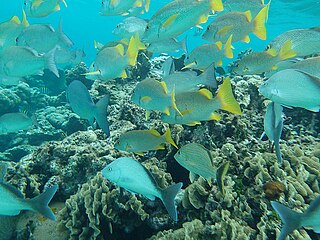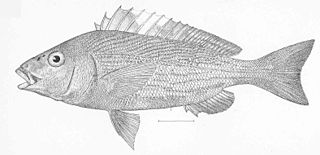
Haemulidae is a family of fishes in the order Perciformes known commonly as grunts. It is made up of the two subfamilies Haemulinae (grunters) and Plectorhynchinae (sweetlips), which in turn contain about 133 species in 19 genera. These fish are found in tropical fresh, brackish, and salt waters around the world. They are bottom-feeding predators, and named for the ability of Haemulinae to produce sound by grinding their teeth. They also engage in mutualistic relationship with cleaner gobies of genus Elacatinus, allowing them to feed on ectoparasites on their bodies.

The Caesar grunt, also known as the black grunt, blacktail grunt, or redmouth grunt is a species of marine ray-finned fish, a grunt in the family Haemulidae. It is native to the western Atlantic Ocean.

The brownstriped grunt, also known as the burro, is a species of marine ray-finned fish, a grunt belonging to the family Haemulidae. It is native to the western Atlantic Ocean.

Plectorhinchus albovittatus, the two-striped sweetlips or giant sweetlips, is a species of marine ray-finned fish, a sweetlips belonging to the subfamily Plectorhinchinae, part of the grunt family Haemulidae. It is native to the Indian Ocean and the western Pacific Ocean.

The bluestriped grunt, also known as the boar grunt, golden grunt, humpback grunt, redmouth grunt, or yellow grunt, is a species of marine ray-finned fish, a grunt belonging to the family Haemulidae. It is found in the western Atlantic Ocean.

Haemulon flavolineatum, the French grunt, banana grunt, gold laced grunt, open-mouthed grunt, redmouth grunt, or yellow grunt, is a species of marine ray-finned fish, a grunt belonging to the family Haemulidae. It is native to the western Atlantic Ocean.

Haemulon is a genus of fish in the grunt family known as the scaled-fin grunts. Most are found in the western Atlantic Ocean, with a few species known from the eastern Pacific Ocean. This genus is considered to be one of the most important fish groups of the coral reefs of Brazil due to its commercial value and crucial ecological role.

Genyatremus luteus, the Torroto grunt, is a species of marine ray-finned fish, a sweetlips belonging to the subfamily Plectorhinchinae of the family Haemulidae. It is native to the Atlantic coast of South America from Colombia to Brazil.
The dara is a species of marine ray-finned fish, a grunt belonging to the family Haemulidae. It is native to the Atlantic coast of Africa. It is the only species in the monospecific genus Parakuhlia.

Xenistius is a genus of grunts native to the eastern Pacific Ocean.

Haemulon chrysargyreum, the smallmouth grunt, bronze grunt, or yellowstripe grunt, is a species of marine ray-finned fish, a grunt belonging to the family Haemulidae. It is found in the western Atlantic Ocean.

Haemulon scudderii, the grey grunt, golden-eye grunt, or mojarra grunt, is a species of marine ray-finned fish, a grunt belonging to the family Haemulidae. It is found in the eastern Pacific Ocean.

Pomadasys kaakan, the javelin grunter or barred javelin is a species of marine ray-finned fish, a grunt belonging to the family Haemulidae. It is native to the Indian and Pacific Oceans, from Africa to Australia.

Orthopristis chrysoptera, the pigfish, hogfish, piggy perch, redmouth grunt or sailor's choice, is a species of marine ray-finned fish, a grunt belonging to the family Haemulidae. It is found in the western Atlantic Ocean. This name derives from the grunting or chattering noise these fish make by rubbing their pharyngeal teeth together.

Haemulon album, the white margate, grey grunt, grunt, Margaret fish, Margaret grunt, margate, margate fish, ronco blanco, viuda, white grunt, white pogret, or yellow grunt is a species of ray-finned fish, a large grunt belonging to the family Haemulidae. It is native to the western Atlantic Ocean.

Haemulinae is a subfamily of the Haemulidae and consists of the genera of that family which are regarded as being of New World origin, although they are now widespread. The subfamily is distinguished from the Plectorhynchinae by having a short dorsal fin which contains 13-16 soft rays, as opposed to the long dorsal fin with 17-26 soft rays of the subfamily Plectorhynchinae.

Brachygenys is a genus of marine ray-finned fish, grunts belonging to the family Haemulidae. The species within the genus are found in the eastern Pacific Ocean and western Atlantic Ocean. It is not yet recognised by Fishbase but is by the Catalog of Fishes.

Orthopristis reddingi, the bronze-striped grunt, is a species of ray-finned fish, a grunt belonging to the family Haemulidae. It is endemic to Mexico, occurring from central Baja California, including the southern Sea of Cortez, to central Mexico. It is found in schools over sandy substrates in coastal waters and the juveniles are frequently recorded in tidal pools. They are found at depths between 5 and 30 m. This species was first formally described in 1895 by the American ichthyologists David Starr Jordan and Robert Earl Richardson, the type locality was given as La Paz, Baja California Sur. The specific name honours in Benjamin B. Redding (1824-1882), the politician who was the first Fish Commissioner of California.

Pomadasys argenteus, the silver grunt, silver javelin, grunter bream, small-spotted grunter-bream, small-spotted javelin fish, trumpeter or white-finned javelin fish, is a species of marine ray-finned fish, a grunt from the family Haemulidae. This species has a wide Indo-Pacific distribution. It is the type species of the genus Pomadasys.

The African striped grunt is a species of marine ray-finned fish, a sweetlips belonging to the subfamily Plectorhinchinae, one of two subfamilies in the family Haemulidae, the grunts. It is found in the eastern Atlantic Ocean.


















